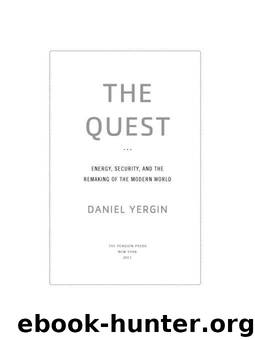The Quest: Energy, Security, and the Remaking of the Modern World by Yergin Daniel

Author:Yergin, Daniel [Yergin, Daniel]
Language: eng
Format: mobi, epub
Publisher: Penguin Group
Published: 2011-09-19T16:00:00+00:00
ARRHENIUS: THE GREAT BENEFIT OF A WARMING CLIMATE
The year after Tyndall’s death, in 1894, a Swedish chemist named Svante Arrhenius picked up the story. Arrhenius was curious as to what effects increasing or decreasing levels of carbon dioxide—or carbonic acid, as it was called at the time—would have on the climate. He too wanted to weigh in on the mechanisms of the ice ages, the advance and retreat of glaciers, and what he called “some points in geological climatology.”
Arrhenius’s own academic career was not smooth. He had difficulty getting his Ph.D. accepted at the University of Uppsala. But now, more established in Stockholm, he found his interest in carbon and the ice age stoked in a scientific seminar that met on Saturdays. Melancholic over his divorce and loss of custody of his son, and with much time on his hands, Arrehenius threw himself into month after month of tedious calculations, sometimes working 14 hours a day, proceeding latitude by latitude, trying by hand to calculate the effects of changes in carbon.
After a year, Arrhenius had the results. Invoking Tyndall and Fourier, he said, “A great deal has been written on the influence of the absorption of the atmosphere upon the climate.” His calculations showed that cutting atmospheric carbon in half would lower the world’s temperature by about four to five degrees centigrade. Additional work indicated that a doubling of carbon dioxide would increase temperatures by five to six degrees centigrade. Arrhenius did not have the benefit of supercomputers and advanced computation; he arrived at the above prediction after a tediously huge number of calculations by hand. Nonetheless, his results are in the range of contemporary models.9
Even if he was the first to predict, at least to some degree, global warming, Arrhenius was certainly not worried about the possibility. He thought it would take 3,000 years for CO2 to double in the atmosphere, and in any event that would be a good thing. He later mused that the increased CO2 concentrations would not only prevent a new ice age but would actively allow mankind to “enjoy ages with more equable and better climates,” especially in “the colder regions of the earth,” and that would “bring forth much more abundant crops than at present for the benefit of rapidly propagating mankind.” And that did not sound at all bad to a lonely Swedish chemist who knew all too well what it was like to live, year after year, through long, dark, cold winters.10
“My grandfather rang a bell, indeed, and people became extremely interested in it at that time,” said his grandson Gustaf Arrhenius, himself a distinguished chemist. “There was a great flurry of interest in it, but not because of the menace, but because it would be so great. He felt that it would be marvelous to have an improved climate in the ‘northern climes.’ And, in addition, the carbon dioxide would stimulate growth of crops—they would grow better. So he and the people at the time were only sad that in his calculations it would take [so long] to have the marked effect.
Download
The Quest: Energy, Security, and the Remaking of the Modern World by Yergin Daniel.epub
This site does not store any files on its server. We only index and link to content provided by other sites. Please contact the content providers to delete copyright contents if any and email us, we'll remove relevant links or contents immediately.
| Alternative & Renewable | Drilling Procedures |
| Electric | Fossil Fuels |
| Mining | Nuclear |
| Power Systems |
Whiskies Galore by Ian Buxton(41867)
Introduction to Aircraft Design (Cambridge Aerospace Series) by John P. Fielding(33064)
Small Unmanned Fixed-wing Aircraft Design by Andrew J. Keane Andras Sobester James P. Scanlan & András Sóbester & James P. Scanlan(32743)
Craft Beer for the Homebrewer by Michael Agnew(18140)
Turbulence by E. J. Noyes(7935)
The Complete Stick Figure Physics Tutorials by Allen Sarah(7307)
Kaplan MCAT General Chemistry Review by Kaplan(6866)
The Thirst by Nesbo Jo(6826)
Bad Blood by John Carreyrou(6543)
Modelling of Convective Heat and Mass Transfer in Rotating Flows by Igor V. Shevchuk(6391)
Learning SQL by Alan Beaulieu(6208)
Weapons of Math Destruction by Cathy O'Neil(6139)
Man-made Catastrophes and Risk Information Concealment by Dmitry Chernov & Didier Sornette(5921)
Digital Minimalism by Cal Newport;(5661)
Life 3.0: Being Human in the Age of Artificial Intelligence by Tegmark Max(5474)
iGen by Jean M. Twenge(5366)
Secrets of Antigravity Propulsion: Tesla, UFOs, and Classified Aerospace Technology by Ph.D. Paul A. Laviolette(5309)
Design of Trajectory Optimization Approach for Space Maneuver Vehicle Skip Entry Problems by Runqi Chai & Al Savvaris & Antonios Tsourdos & Senchun Chai(5011)
Electronic Devices & Circuits by Jacob Millman & Christos C. Halkias(4907)
